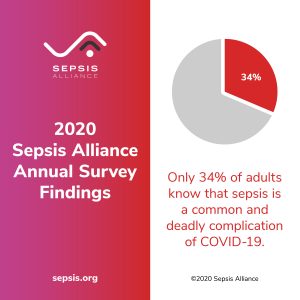Sepsis is a deadly complication of COVID-19, but more than 60% of adults don’t know.
September 6, 2020
The 2020 Sepsis Alliance Annual Survey reveals that as sepsis awareness reaches a record high, deep racial and ethnic disparities remain.
Timed to coincide with Sepsis Awareness Month, Sepsis Alliance, the first and leading sepsis organization, released the results of its 2020 Sepsis Alliance Annual Survey of among more than 2,000 adults in the United States. The survey, conducted by Radius Global Market Research, found that awareness of the term sepsis has reached a new all-time high of 71%. However, it also found that only one-third of adults are aware that sepsis is a potential complication of COVID-19.1,2. In addition, only 15% of adults can identify all four common signs and symptoms of sepsis, and one-quarter do not know any of the symptoms.
Sepsis is a prolific and deadly, but often overlooked, disease that takes approximately 270,000 lives a year in the United States alone.3 Yet, as many as 80% of sepsis deaths could be prevented with rapid diagnosis and treatment.4
“Awareness of sepsis and its signs and symptoms is critical to saving lives. It empowers individuals to recognize the signs and symptoms of sepsis in themselves, and others, and get the rapid life-saving treatment they need,” said Karin Molander, MD, FACEP, chair of the Sepsis Alliance Board of Directors. “During the current pandemic, the need for sepsis awareness is heightened because sepsis is the most common complication observed in severe cases of COVID-19”
 Further analysis of the data exposes deep racial and ethnic disparities in sepsis awareness. The survey found that 76% of people who identify as white are aware of the term sepsis, while 63% of people who identify as Hispanic are aware of the term, and only 49% of people who identify as Black are aware. Furthermore, only 5% of people who identify as Black can identify all four common symptoms of sepsis. Of people who identify as white, 18% can identify these four symptoms.
Further analysis of the data exposes deep racial and ethnic disparities in sepsis awareness. The survey found that 76% of people who identify as white are aware of the term sepsis, while 63% of people who identify as Hispanic are aware of the term, and only 49% of people who identify as Black are aware. Furthermore, only 5% of people who identify as Black can identify all four common symptoms of sepsis. Of people who identify as white, 18% can identify these four symptoms.
This is especially concerning because Black and Hispanic (Latino) people are disproportionately affected by COVID-19 in the United States. They are four times more likely to be hospitalized with COVID-19 than white people are.5 The gap in sepsis awareness between these populations is most likely a result of health inequities in the United States,6 and may very well be contributing to the disparate impact COVID-19 is having on communities of color.
The survey also found that awareness of the term sepsis is correlated with income. 79% of people with an annual income of $75,000 or more annually are aware of the term, whereas only 64% of people with an annual income of $50,000 or less are aware of the term.
Sepsis has a high mortality rate, but with the advancement in care and increased awareness, there are many survivors. 1.4 million people in the United States survive sepsis every year.3 However, many of them face long-term mental, emotional, and physical challenges. The survey found that 35% of people know someone who has had sepsis, including themselves. Of those who had sepsis, 30% report facing mental health challenges.
Sepsis Awareness has increased by 31% since 2012, when Sepsis Alliance conducted its first online survey. However, increased awareness of the signs and symptoms is still necessary as it remains low (15%) generally, and increased awareness of sepsis is especially needed in communities of color, which have been hit hardest by COVID-19.
The 2020 Sepsis Alliance Annual Survey results can be found here: PDF.
This Sepsis Awareness Month, Sepsis Alliance is inviting the public, media, and healthcare providers to take the TIME to save lives. To learn more about Sepsis Awareness Month and how to get involved, please visit www.SepsisAwarenessMonth.org.
Methodology
The survey was conducted online within the United States by Radius Global Market Research on behalf of Sepsis Alliance on June 2-3, 2020, among more than 2,000 adults living in the U.S. The results were weighted to the U.S. census for age, gender, region and income. Surveys were conducted in English.
About Sepsis Alliance
Sepsis Alliance is the leading sepsis organization in the U.S., working to save lives and reduce suffering by improving sepsis awareness and care. In 2011, Sepsis Alliance designated September as Sepsis Awareness Month to bring healthcare professionals and community members together in the fight against sepsis. Sepsis Alliance gives a voice to the millions of people who have been touched by sepsis – to the survivors, and the friends and family members of those who have survived or who have died. Since 2003, sepsis awareness in the U.S. has risen from 19% to 71%. Sepsis Alliance is a GuideStar Platinum Rated charity. For more information, please visit www.sepsis.org. Connect with us on Facebook and Twitter at @SepsisAlliance.
- Zhou F, et al. Lancet. 2020;395(10229):1054-1062. https://www.thelancet.com/journals/lancet/article/PIIS0140-6736(20)30566-3/fulltext
- Chen T, et al. BMJ. 2020;368:m1091. https://www.bmj.com/content/368/bmj.m1091
- Rhee C, et al. JAMA. 2017;318(13):1241-1249. https://jamanetwork.com/journals/jama/fullarticle/2654187
- Kumar A, et al. Crit Care Med. 2006;34(6):1589-1596. https://pubmed.ncbi.nlm.nih.gov/16625125/
- COVID-19 Hospitalization and Death by Race/Ethnicity, CDC. Accessed Aug 18, 2020. https://www.cdc.gov/coronavirus/2019-ncov/covid-data/investigations-discovery/hospitalization-death-by-race-ethnicity.html
- Health Equity Considerations and Racial and Ethnic Minority Groups, CDC. Accessed Aug 18, 2020. https://www.cdc.gov/coronavirus/2019-ncov/community/health-equity/race-ethnicity.html





























